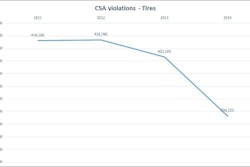If you missed Heavy Duty Aftermarket Dialogue last week (or our coverage of it), one theme that resonated through most of the economic discussion was the relative consistency of the aftermarket.
It was mentioned that while new truck sales regularly flow in cycles—we’ve just dipped into a slight downturn, as I’m sure you’ve guessed—the aftermarket is much steadier in its growth and expansion. According to data presented last Monday by MacKay & Company, the North American aftermarket has grown year-over-year since the last recession, and is predicted to continue its growth through 2020.
That prediction was reiterated the next day, when IHS Automotive released its yearly update on the commercial vehicle industry and was equally bullish on the aftermarket.
Interestingly, both data houses cite the fluctuation of new truck sales as one of the major reasons for the stability.
Troughs in new truck builds are devastating for dealers because they don’t just kill showroom profitability but also slow service opportunities. Less new trucks means less warranty work and related repairs.
The aftermarket doesn’t experience any of that.
Yes, it’s true that there are more 2011 and 2012 tractors entering the aftermarket this year than there were 2009 and 2010 tractors in recent past, but at no point during these past few years has the aftermarket been forced to rely on these newly accessible units alone. The dealer service market is captive but brief. Once a truck reaches the aftermarket, it stays in the aftermarket.
And IHS Automotive says the upcoming aftermarket parts sales opportunities are vast.
“… Many general maintenance parts will have strong demand during the 2016 calendar year,” IHS says. “A few of these key components and their anticipated demand in the next 12 months are: diesel oil filters (32m), diesel fuel filters (19m), diesel air filters (10m), shock absorbers (4m), intake exhaust valves (7m), hydraulic brake pad sets (3m).”
Trucks purchased in the previous sales boom (2005 to 2008) that are still in use also will require those parts, IHS adds, as well as longer life-cycle parts such as “in-frame kits (259,000), replacement engines (13,000), cylinder heads (50,000), fuel pumps (400,000) and engine control modules (348,000).”
And when those trucks finally age out of the population, trucks from the 2011-2014 boom will be needing the same aftermarket repairs.
To me, it’s almost reminiscent of the tortoise and the hare. Truck OEMs sell a pile of trucks and make a fortune, then slow to a lurch. Good times are immediately followed by tough times, and while they’re always moving forward, it’s hardly a leisurely or enjoyable pace.
That’s what we get to enjoy. And for an industry filled with small businesses, I think an economic forecast of slow and steady growth is about the best thing we can hope for.










